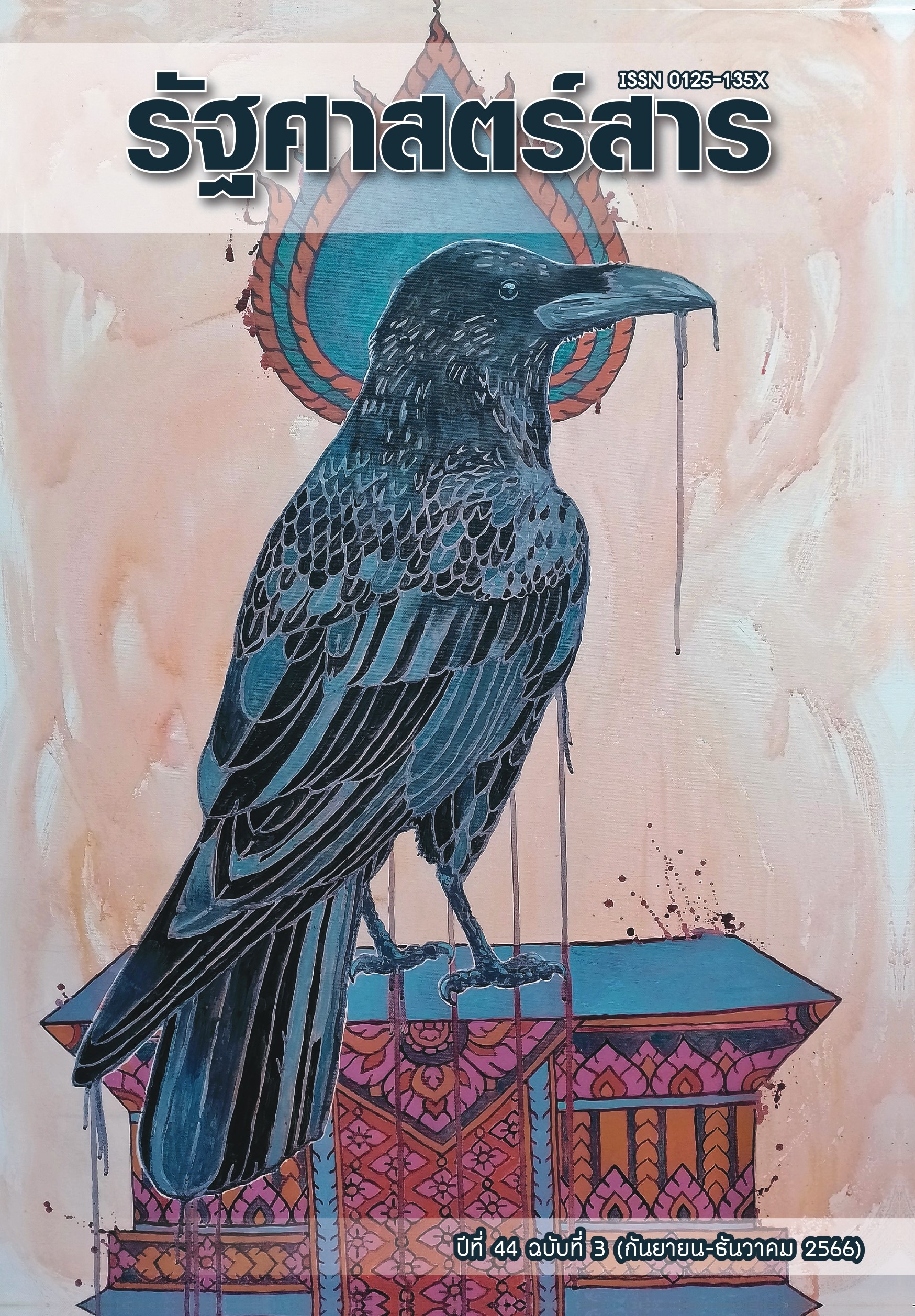รื้อถอนสภาวะอาณานิคมและการสร้างโลกผ่านการเล่าซ้ำปรัมปราในวรรณกรรมของ Easterine Kire
Main Article Content
บทคัดย่อ
บทความนี้มีเป้าหมายเพื่อทำความเข้าใจภูมิปัญญาเชิงนิเวศของชาวนากาผ่านวรรณกรรมของ Easterine Kire ซึ่งเป็นวรรณกรรมที่นำมุขปาฐะของชาวนากามาเล่าใหม่ วรรณกรรมของเธอมุ่งไปที่การโต้ตอบกับมรดกของลัทธิอาณานิคม รวมถึงการหาทางเลือกอื่นที่นอกเหนือจากแนวคิดชาตินิยมที่มาพร้อมกับคริสต์ศาสนา Kire นำตำนานปรัมปราของนากามาเพื่อเล่าเรื่องความสัมพันธ์ทางสังคมและโลกของชาวนากาขึ้นมาใหม่ที่มีลักษณะเชื่อมโยงกันของบุคคลต่าง ๆ ทั้งที่เป็นมนุษย์และสิ่งที่ไม่ใช่มนุษย์ ข้อเสนอของบทความคือ วรรณกรรมของเธอคือการหันไปสู่คำถามว่าด้วยสภาวะของโลกของชาวนากาซึ่งเป็นสภาวะการดำรงอยู่ที่ชาวนากามีร่วมกัน โดยที่ความเป็นนากาหมายรวมถึงทั้งสิ่งที่เป็นมนุษย์และไม่ใช่มนุษย์ เรื่องเล่าของเธอมุ่งไปสู่การปฏิเสธการมองว่า “โลก” ดำรงอยู่อยู่แล้วแบบตายตัวและเปลี่ยนแปลงไม่ได้ แต่โลกก็คือกระบวนการที่ก่อรูปขึ้นใหม่อยู่ตลอดเวลาท่ามกลางความสัมพันธ์ของสิ่งต่าง ๆ ในแง่นี้ ภูมิปัญญาเชิงนิเวศของชาวนากาไม่เพียงแต่เป็นการจัดวางความสัมพันธ์ระหว่างตนเองกับโลกเท่านั้น แต่ยังสามารถเป็นพลังทางการเมืองได้ในฐานะที่แสดงให้เห็นการต่อต้านข้อจำกัดของมโนทัศน์บุคคลตามจารีตแบบตะวันตก ดังนั้น เรื่องเล่าใหม่เหล่านี้จึงไม่ได้ทำหน้าที่แค่ปลดปล่อยชนชาวนากาออกจากชาตินิยมอินเดียและอาณานิคมอังกฤษเท่านั้น แต่เรื่องเล่าใหม่นี้กลับเปิดพื้นที่ให้กับการคิดและจินตนาการถึงการปลดปล่อยอินเดียออกจากมรดกลัทธิอาณานิคมได้ด้วย กล่าวดังนี้แล้ว วรรณกรรมของ Kire คือกระบวนการสำรวจตรวจสอบเพื่อรื้อถอนสภาวะอาณานิคม เพื่อชี้ให้เห็นข้อจำกัดและอำนาจครอบงำของอาณานิคมและชาตินิยม พร้อมทั้งเสนอทางออกคือ การกลับไปหาภูมิปัญญาเชิงนิเวศของชาวนากา
Article Details
เอกสารอ้างอิง
I Watitula Longkumer and Nirmala Menon, “Return of the Spirits: An Interview with Easterine Kire,” English: Journal of the English Association, Vol. 68, No. 263 (Winter 2019), 389–399.
Mariom Wettstein, “Origin and Migration Myths in the Rhetoric of Naga Independence and Collective Identity,” in Toni Huber and Stuart Blackburn (Eds.), Origins and Migrations in the Extended Eastern Himalayas, (Leiden and Boston: Brill, 2012), 213–238.
Tezenlo Thong, Colonization, Proselytization, and Identity: The Nagas and Westernization in Northeast India, (Springer International Publishing, 2016), 6.
Chongpongmeren Jamir, Christianity in Northeast India: A Cultural History of Nagaland from 1947, (London and New York: Routledge, 2020), 11.
Veio Pou, “‘Years of listening to stories grows a wealth of knowledge within your spirit’: Easterine Kire,” Scroll (Website), https://scroll.in/article/971141/years-of-listening-to-stories-grows-a-wealth-of-knowledge-within-your-spirit-easterine-kire (Retrieved 2 September 2022).
I Watitula Longkumer and Nirmala Menon, “Return of the Spirits: An Interview with Easterine Kire,” Cited.
Tezenlo Thong, Colonization, Proselytization, and Identity: The Nagas and Westernization in Northeast India, Cited, 15-19.
Julian Jacobs, The Nagas, Hill Peoples of Northeast India: Society, Culture and the Colonial Encounter, Revised Edition, (Bangkok: River Books, 2012), 154.
Tezenlo Thong, Colonization, Proselytization, and Identity: The Nagas and Westernization in Northeast India, Cited, 37-40.
Julian Jacobs, The Nagas, Hill Peoples of Northeast India: Society, Culture and the Colonial Encounter, Cited, 153.
Tezenlo Thong, Colonization, Proselytization, and Identity: The Nagas and Westernization in Northeast India, Cited, 20.
Shonreiphy Longvah, “Christian Conversion, The Rise of Naga National Consciousness, and Naga Nationalist Politics,” The South Asianist, Vol. 5, No. 1 (Spring 2017), 121-139.
John Thomas, Evangelising the Nation: Religion and the Formation of Naga Political Identity. (New Delhi, London, and New York: Routledge, 2016), 4.
ธเนศ วงศ์ยานนาวา, “จิตวิญญาณคาทอลิกของแอร์เนสต์ เรอนอง,” ใน ชาติคืออะไร?, (กรุงเทพฯ: พารากราฟ, 2560), 83. และดูประเด็นนี้เพิ่มเติมใน Marcel Gauchet, The Disenchantment of the World: Political History of Religion, Trans. Oscar Burge, (Princeton: Princeton University Press, 1997).
Julian Jacobs, The Nagas, Hill Peoples of Northeast India: Society, Culture and the Colonial Encounter, Cited, 151.
Easterine Kire, Bitter Wormwood, (New Delhi: Zubaan, 2011), 249.
Mariom Wettstein and Alban von Stockhausen, “Connecting to the Past,” in Julian Jacobs (Ed.), The Nagas: Hill Peoples of Northeast India-Society, Culture and the Colonial Encounter, Extended New Edition, (London: Edition Hansjörg Mayer, 2012), ii.
Julian Jacobs, The Nagas, Hill Peoples of Northeast India: Society, Culture and the Colonial Encounter, Cited, 152.
Sajal Nag, “Expanding imaginations: theory and praxis of Naga nation making in postcolonial India,” South Asian History and Culture, Vol. 3, No. 2, (2012), 177-196.
Mariom Wettstein and Alban von Stockhausen, “Connecting to the Past,” Cited, ii.
Vibha Joshi, “The Micropolitics of Borders: The Issue of Greater Nagaland (or Nagalim),” in David Gellner (Ed.), Borderland lives in Northern South Asia, (Durham, NC: Duke University Press, 2013), 163–193.
Sanjib Baruah, In the Name of the Nation: India and Its Northeast, (Stanford and California: Stanford University Press, 2020), 113.
Shonreiphy Longvah, “Christian Conversion, The Rise of Naga National Consciousness, and Naga Nationalist Politics,” Cited, 121-139.
Mariom Wettstein, “Origin and Migration Myths in the Rhetoric of Naga Independence and Collective Identity,” Cited.
Sanjib Baruah, In the Name of the Nation: India and Its Northeast, Cited, 107.
Mariom Wettstein and Alban von Stockhausen, “Connecting to the Past,” Cited, v.
Veio Pou, “‘Years of listening to stories grows a wealth of knowledge within your spirit’: Easterine Kire,” Cited.
Mariom Wettstein and Alban von Stockhausen, “Connecting to the Past,” Cited.
Easterine Kire, Bitter Wormwood, (New Delhi: Zubaan, 2011), 237.
Roberto Esposito, Persons and Things: from the body's point of view, Trans. Zakiya Hanafi, (Cambridge and Malden: Polity, 2015).
Roberto Esposito, Third Person, Trans. Zakiya Hanafi, (Cambridge and Malden: Polity, 2012).
Eduardo Viveiros de Castro, Cannibal Metaphysics, Trans. Peter Skafish, (Minneapolis: Univocal, 2014); The Relative Native: Essays on Indigenous Conceptual Worlds, Trans. Martin Holbraad et al., (Illinois: HAU, 2016) .และดูเพิ่มเติมใน เก่งกิจ กิติเรียงลาภ, Perspective: ภววิทยาแบบมุมมองนิยมและความเป็นซับเจค, (กรุงเทพฯ: Illuminations Editions, 2563).
Easterine Kire, The Rain-Maiden and the Bear-Man, (New Delhi: Seagull Books, 2021), 62.
Eduardo Viveiros de Castro, Cannibal Metaphysics, Cited, 71.
Easterine Kire, Don’t Run, My Love, (New Delhi: Speaking Tiger Books, 2017), 92.
Eduardo Viveiros de Castro, “Cosmological Deixis and Amerindian Perspectivism,” Journal of Royal Anthropological Institute, Vol. 4, No. 3, (1998), 469-488.
Walter D. Mignolo, The Politics of Decolonial Investigation, (Durham and London: Duke University Press, 2021), 3.
Philippe Descola, Beyond Nature and Culture, Trans. Janet Lloyd, (Chicago: Chicago University Press, 2013).
Roberto Esposito, Communitas: The Origin and Destiny of Community, Trans. Timothy Campbell, (Stanford: Stanford University Press, 2010); Roberto Esposito, Immunitas: The Protection and Negation of Life, Trans. Zakiya Hanafi, (Cambridge and Malden: Polity, 2011).
Marilyn Strathern, “Opening Up Relations,” in Marisol de la Cadena and Mario Blaser (Eds.), A World of Many Worlds, (Durham and London: Duke University Press, 2018), 23-52.; เก่งกิจ กิติเรียงลาภ และพนา กันธา, Pluriverse: จริยศาสตร์แห่งการอยู่ร่วมกันข้ามพรมแดนความเป็นมนุษย์, (กรุงเทพฯ: หน่วยบริหารและจัดการทุนด้านพัฒนากำลังคนและทุนด้านการพัฒนาสถาบันอุดมศึกษา การวิจัยและการสร้างนวัตกรรม, 2565).


